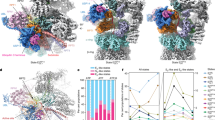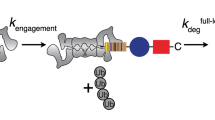Abstract
Changes in the cellular environment modulate protein energy landscapes to drive important biology, with consequences for signaling, allostery and other vital processes. The effects of ubiquitination are particularly important because of their potential influence on degradation by the 26S proteasome. Moreover, proteasomal engagement requires unstructured initiation regions that many known proteasome substrates lack. To assess the energetic effects of ubiquitination and how these manifest at the proteasome, we developed a generalizable strategy to produce isopeptide-linked ubiquitin within structured regions of a protein. The effects on the energy landscape vary from negligible to dramatic, depending on the protein and site of ubiquitination. Ubiquitination at sensitive sites destabilizes the native structure and increases the rate of proteasomal degradation. In well-folded proteins, ubiquitination can even induce the requisite unstructured regions needed for proteasomal engagement. Our results indicate a biophysical role of site-specific ubiquitination as a potential regulatory mechanism for energy-dependent substrate degradation.

This is a preview of subscription content, access via your institution
Access options
Access Nature and 54 other Nature Portfolio journals
Get Nature+, our best-value online-access subscription
$29.99 / 30 days
cancel any time
Subscribe to this journal
Receive 12 print issues and online access
$259.00 per year
only $21.58 per issue
Buy this article
- Purchase on Springer Link
- Instant access to full article PDF
Prices may be subject to local taxes which are calculated during checkout





Similar content being viewed by others
Data availability
The data that support the findings of this study are available within the manuscript and its supplementary information or from the corresponding author upon reasonable request. All constructs generated for this study are also available from the corresponding author upon reasonable request. Source data for Figs. 2–4 are presented with the paper.
References
Raschke, T. M., Kho, J. & Marqusee, S. Confirmation of the hierarchical folding of RNase H: a protein engineering study. Nat. Struct. Biol. 6, 825–830 (1999).
Kenniston, J. A., Burton, R. E., Siddiqui, S. M., Baker, T. A. & Sauer, R. T. Effects of local protein stability and the geometric position of the substrate degradation tag on the efficiency of ClpXP denaturation and degradation. J. Struct. Biol. 146, 130–140 (2004).
Liu, T., Whitten, S. T. & Hilser, V. J. Ensemble-based signatures of energy propagation in proteins: a new view of an old phenomenon. Proteins Struct. Funct. Genet 62, 728–738 (2006).
Martin, A., Baker, T. A. & Sauer, R. T. Protein unfolding by a AAA+ protease is dependent on ATP-hydrolysis rates and substrate energy landscapes. Nat. Struct. Mol. Biol. 15, 139–145 (2008).
Xin, F. & Radivojac, P. Post-translational modifications induce significant yet not extreme changes to protein structure. Bioinformatics 28, 2905–2913 (2012).
Swatek, K. N. & Komander, D. Ubiquitin modifications. Cell Res. 26, 399–422 (2016).
Prakash, S., Tian, L., Ratliff, K. S., Lehotzky, R. E. & Matouschek, A. An unstructured initiation site is required for efficient proteasome-mediated degradation. Nat. Struct. Mol. Biol. 11, 830–837 (2004).
Yu, H. & Matouschek, A. Recognition of client proteins by the proteasome. Annu. Rev. Biophys. 46, 149–173 (2017).
Hagai, T., Azia, A., Tóth-Petróczy, Á. & Levy, Y. Intrinsic disorder in ubiquitination substrates. J. Mol. Biol. 412, 319–324 (2011).
Godderz, D. et al. Cdc48-independent proteasomal degradation coincides with a reduced need for ubiquitylation. Sci. Rep. 5, 1–8 (2015).
Tsuchiya, H. et al. In vivo ubiquitin linkage-type analysis reveals that the Cdc48-Rad23/Dsk2 axis contributes to K48-linked chain specificity of the proteasome. Mol. Cell 66, 488–502.e7 (2017).
Olszewski, M. M., Williams, C., Dong, K. C. & Martin, A. The Cdc48 unfoldase prepares well-folded protein substrates for degradation by the 26S proteasome. Commun. Biol 2, 29 (2019).
Hagai, T. & Levy, Y. Ubiquitin not only serves as a tag but also assists degradation by inducing protein unfolding. Proc. Natl Acad. Sci. USA 107, 2001–2006 (2010).
Gavrilov, Y., Hagai, T. & Levy, Y. Nonspecific yet decisive: ubiquitination can affect the native-state dynamics of the modified protein. Protein Sci. 24, 1580–1592 (2015).
Faggiano, S. & Pastore, A. The challenge of producing ubiquitinated proteins for structural studies. Cells 3, 639–656 (2014).
Morimoto, D., Walinda, E., Fukada, H., Sugase, K. & Shirakawa, M. Ubiquitylation directly induces fold destabilization of proteins. Sci. Rep. 6, 39453 (2016).
Cundiff, M. D. et al. Ubiquitin receptors are required for substrate-mediated activation of the proteasome’s unfolding ability. Sci. Rep. 9, 14506 (2019).
Saeki, Y., Isono, E. & Toh-E, A. Preparation of ubiquitinated substrates by the PY motif-insertion method for monitoring 26S proteasome activity. Methods Enzymol. 399, 215–227 (2005).
Kim, H. C., Steffen, A. M., Oldham, M. L., Chen, J. & Huibregtse, J. M. Structure and function of a HECT domain ubiquitin-binding site. EMBO Rep. 12, 334–341 (2011).
Kamadurai, H. B. et al. Mechanism of ubiquitin ligation and lysine prioritization by a HECT E3. eLife 2013, 1–26 (2013).
Khurana, Ritu, Hate, AnitaT., Nath, Utpal & Udgaonkar, J. B. pH dependence of the stability of barstar to chemical and thermal denaturation. Protein Sci. 4, 1133–1144 (1995).
Myers, J. K., Pace, C. N. & Scholtz, J. M. Denaturant m values and heat capacity changes: relation to changes in accessible surface areas of protein unfolding. Protein Sci. 4, 2138–2148 (1995).
Nolting, B. et al. The folding pathway of a protein at high resolution from microseconds to seconds. Proc. Natl Acad. Sci. USA 94, 826–830 (1997).
Zaidi, F. N., Nath, U. & Udgaonkar, J. B. Multiple intermediates and transition states during protein unfolding. Nat. Struct. Biol. 4, 1016–1024 (1997).
Park, C. & Marqusee, S. Probing the high energy states in proteins by proteolysis. J. Mol. Biol. 343, 1467–1476 (2004).
Park, C. Probing transient partial unfolding in proteins by native‐state proteolysis.Bio. Des.3, 117–128.
Bard, J. A. M., Bashore, C., Dong, K. C. & Martin, A. The 26S proteasome utilizes a kinetic gateway to prioritize substrate degradation. Cell 177, 286–298.e15 (2019).
Bashore, C. et al. Ubp6 deubiquitinase controls conformational dynamics and substrate degradation of the 26S proteasome. Nat. Struct. Mol. Biol. 22, 1–10 (2015).
Chojnacki, M. et al. Polyubiquitin-photoactivatable crosslinking reagents for mapping ubiquitin interactome identify Rpn1 as a proteasome ubiquitin-associating subunit. Cell Chem. Biol. 24, 443–457.e6 (2017).
Lee, C., Schwartz, M. P., Prakash, S., Iwakura, M. & Matouschek, A. ATP-dependent proteases degrade their substrates by processively unraveling them from the degradation signal. Mol. Cell 7, 627–637 (2001).
Twomey, E. C. et al. Substrate processing by the Cdc48 ATPase complex is initiated by ubiquitin unfolding. Science 365, eaax1033 (2019).
De la Peña, A. H., Goodall, E. A., Gates, S. N., Lander, G. C. & Martin, A. Substrate-engaged 26S proteasome structures reveal mechanisms for ATP-hydrolysis–driven translocation. Science 362, eaav0725 (2018).
Worden, E. J., Dong, K. C. & Martin, A. An AAA motor-driven mechanical switch in Rpn11 Controls Deubiquitination at the 26S Proteasome. Mol. Cell 67, 799–811.e8 (2017).
Greene, E. R. et al. Specific lid-base contacts in the 26S proteasome control the conformational switching required for substrate engagement and degradation. eLife 8, https://doi.org/10.1101/687921 (2019).
Reichard, E. L. et al. Substrate ubiquitination controls the unfolding ability of the proteasome. J. Biol. Chem. 291, jbc.M116.720151 (2016).
Guo, Q. et al. In situ structure of neuronal C9orf72 poly-GA aggregates reveals proteasome recruitment. Cell 172, 696–705.e12 (2018).
Komander, D. & Rape, M. The ubiquitin code. Annu. Rev. Biochem. 81, 203–229 (2012).
Sakamoto, K. M. et al. Protacs: chimeric molecules that target proteins to the Skp1-Cullin-F box complex for ubiquitination and degradation. Proc. Natl Acad. Sci. USA 98, 8554–8559 (2001).
Nowak, R. P. et al. Plasticity in binding confers selectivity in ligand-induced protein degradation article. Nat. Chem. Biol. 14, 706–714 (2018).
Smith, B. E. et al. Differential PROTAC substrate specificity dictated by orientation of recruited E3 ligase. Nat. Commun. 10, 1–13 (2019).
Huang, H. T. et al. A chemoproteomic approach to query the degradable kinome using a multi-kinase degrader. Cell Chem. Biol. 25, 88–99.e6 (2018).
Bondeson, D. P. et al. Lessons in PROTAC design from selective degradation with a promiscuous warhead. Cell Chem. Biol. 25, 78–87.e5 (2018).
Batey, S., Nickson, A. A. & Clarke, J. Studying the folding of multidomain proteins. HFSP J. 2, 365–377 (2008).
Carrion-Vazquez, M. et al. The mechanical stability of ubiquitin is linkage dependent. Nat. Struct. Biol. 10, 738–743 (2003).
Morimoto, D. et al. The unexpected role of polyubiquitin chains in the formation of fibrillar aggregates. Nat. Commun. 6, 6116 (2015).
Sousa, R. & Lafer, E. M. The physics of entropic pulling: a novel model for the Hsp70 motor mechanism. Int. J. Mol. Sci. 20, 2334 (2019).
Freudenthal, B. D., Gakhar, L., Ramaswamy, S. & Washington, M. T. Structure of monoubiquitinated PCNA and implications for translesion synthesis and DNA polymerase exchange. Nat. Struct. Mol. Biol. 17, 479–484 (2010).
Varadan, R., Walker, O., Pickart, C. & Fushman, D. Structural properties of polyubiquitin chains in solution. J. Mol. Biol. 324, 637–647 (2002).
Eddins, M. J., Varadan, R., Fushman, D., Pickart, C. M. & Wolberger, C. Crystal structure and solution NMR studies of Lys48-linked tetraubiquitin at neutral pH. J. Mol. Biol. 367, 204–211 (2007).
Debelouchina, G. T., Gerecht, K. & Muir, T. W. Ubiquitin utilizes an acidic surface patch to alter chromatin structure. Nat. Chem. Biol. 13, 105–110 (2017).
Beckwith, R., Estrin, E., Worden, E. J. & Martin, A. Reconstitution of the 26S proteasome reveals functional asymmetries in its AAA+ unfoldase. Nat. Struct. Mol. Biol. 20, 1164–1172 (2013).
Matyskiela, M. E., Lander, G. C. & Martin, A. Conformational switching of the 26S proteasome enables substrate degradation. Nat. Struct. Mol. Biol. 20, 781–788 (2013).
Pollard, T. D. MBOC technical perspective: a guide to simple and informative binding assays. Mol. Biol. Cell 21, 4061–4067 (2010).
Acknowledgements
We thank all members of the Marqusee and Martin laboratories for helpful discussions. We also thank B. Maguire and K. Dong for assistance with protein purification and troubleshooting expertise. We acknowledge support from the US National Institutes of Health: grant nos. R01-GM050945 (S.M.) and R01-GM094497 (A.M.). S.M. is a Chan Zuckerberg Biohub investigator. A.M. is an investigator of the Howard Hughes Medical Institute.
Author information
Authors and Affiliations
Contributions
E.C.C. and E.R.G. performed the experiments and analyzed data. E.C.C., E.R.G., A.M. and S.M. contributed to experimental design, data interpretation and manuscript preparation.
Corresponding authors
Ethics declarations
Competing interests
The authors declare no competing interests.
Additional information
Publisher’s note Springer Nature remains neutral with regard to jurisdictional claims in published maps and institutional affiliations.
Supplementary information
Supplementary Information
Supplementary Figs. 1–10.
Source data
Source Data Fig. 2
Full uncropped gels from Fig. 2
Source Data Fig. 3
Full uncropped gels from Fig. 3
Source Data Fig. 4
Full uncropped gels from Fig. 4
Rights and permissions
About this article
Cite this article
Carroll, E.C., Greene, E.R., Martin, A. et al. Site-specific ubiquitination affects protein energetics and proteasomal degradation. Nat Chem Biol 16, 866–875 (2020). https://doi.org/10.1038/s41589-020-0556-3
Received:
Revised:
Accepted:
Published:
Issue Date:
DOI: https://doi.org/10.1038/s41589-020-0556-3
This article is cited by
-
Abnormal protein post-translational modifications induces aggregation and abnormal deposition of protein, mediating neurodegenerative diseases
Cell & Bioscience (2024)
-
Ubiquitin specific peptidase 11 as a novel therapeutic target for cancer management
Cell Death Discovery (2022)
-
Ubiquitin signaling in neurodegenerative diseases: an autophagy and proteasome perspective
Cell Death & Differentiation (2021)
-
USP3 promotes gastric cancer progression and metastasis by deubiquitination-dependent COL9A3/COL6A5 stabilisation
Cell Death & Disease (2021)
-
Deciphering protein post-translational modifications using chemical biology tools
Nature Reviews Chemistry (2020)



